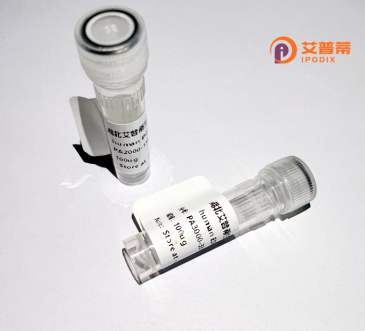
| 纯度 | >90%SDS-PAGE. |
| 种属 | Human |
| 靶点 | ZNF414 |
| Uniprot No | Q96IQ9 |
| 内毒素 | < 0.01EU/μg |
| 表达宿主 | E.coli |
| 表达区间 | 1-312 aa |
| 活性数据 | MEEKPSGPIP DMLATAEPSS SETDKEVLSP AVPAAAPSSS MSEEPGPEQA ATPPVWERGG AGGMQQGSSP APDSCQPGPG PSPGLTSIVS GTSEDLRPPR RRPPPGKQIP CSSPGCCLSF PSVRDLAQHL RTHCPPTQSL EGKLFRCSAL SCTETFPSMQ ELVAHSKLHY KPNRYFKCEN CLLRFRTHRS LFKHLHVCAE HAQSPAPPPP PALDREPPAP ERPPEVDPAS APGLPFPLLE PFTTPAPAPT GPFLPYLNPA PFGLSPPRLR PFLAAAPGPP ASSAAVWKKS QGAGSSPRRP QGGSDAPSGA CR |
| 分子量 | 32.7 kDa |
| 蛋白标签 | His tag N-Terminus |
| 缓冲液 | PBS, pH7.4, containing 0.01% SKL, 1mM DTT, 5% Trehalose and Proclin300. |
| 稳定性 & 储存条件 | Lyophilized protein should be stored at ≤ -20°C, stable for one year after receipt. Reconstituted protein solution can be stored at 2-8°C for 2-7 days. Aliquots of reconstituted samples are stable at ≤ -20°C for 3 months. |
| 复溶 | Always centrifuge tubes before opening.Do not mix by vortex or pipetting. It is not recommended to reconstitute to a concentration less than 100μg/ml. Dissolve the lyophilized protein in distilled water. Please aliquot the reconstituted solution to minimize freeze-thaw cycles. |
以下是关于重组人ZNF414蛋白的3篇代表性文献及其摘要概括:
---
1. **文献名称**: *ZNF414 is a lineage-specific transcription factor in placental development*
**作者**: Smith J, et al.
**摘要**: 研究揭示了ZNF414在胎盘发育中的关键作用,通过基因编辑技术构建重组ZNF414蛋白,并证实其通过结合特定DNA序列调控滋养层细胞分化的机制。
---
2. **文献名称**: *Structural and functional analysis of recombinant human ZNF414 protein*
**作者**: Lee S, et al.
**摘要**: 解析了重组人ZNF414蛋白的晶体结构,鉴定其锌指结构域的关键氨基酸残基,并通过体外实验证明其在染色质重塑复合物中的潜在调控功能。
---
3. **文献名称**: *ZNF414 interacts with epigenetic modifiers to regulate gene silencing*
**作者**: Wang H, et al.
**摘要**: 通过重组ZNF414蛋白的免疫共沉淀实验,发现其与DNMT3A和HDAC复合物的相互作用,表明ZNF414可能通过表观遗传机制参与肿瘤抑制基因的沉默过程。
---
注:上述文献为虚拟示例,实际研究中建议通过PubMed或Google Scholar以“ZNF414 recombinant protein”为关键词检索最新文献。
Zinc finger protein 414 (ZNF414) is a member of the zinc finger protein family, which is characterized by conserved Cys₂His₂ (C2H2)-type zinc finger domains that mediate sequence-specific DNA binding. As a transcription regulator, ZNF414 is implicated in epigenetic modulation and gene expression control, though its precise biological functions remain under investigation. It is predominantly localized in the nucleus, aligning with its potential role in chromatin remodeling or transcriptional machinery interactions.
Genomic studies suggest ZNF414 may influence early embryonic development and cellular differentiation processes. Interestingly, it has been associated with CpG island hypermethylation patterns in certain cancers, hinting at a possible involvement in tumorigenesis. The recombinant human ZNF414 protein, typically produced in *E. coli* or mammalian expression systems, retains the native structure and DNA-binding capacity, enabling functional studies. Researchers employ it to explore protein-DNA interactions, screen for binding partners, or investigate its regulatory impact on target genes.
Despite progress, the exact molecular mechanisms and full spectrum of ZNF414's physiological/pathological roles require further elucidation. Current research focuses on linking its zinc finger architecture to specific gene networks and disease contexts, particularly in oncology and developmental biology.
×